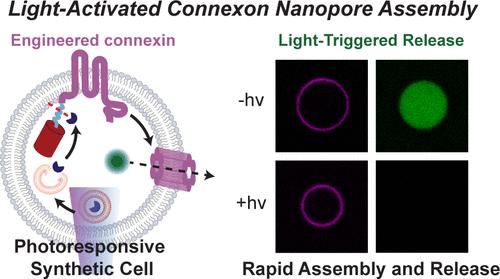当前位置:
X-MOL 学术
›
J. Am. Chem. Soc.
›
论文详情
Our official English website, www.x-mol.net, welcomes your
feedback! (Note: you will need to create a separate account there.)
Light-Activated Assembly of Connexon Nanopores in Synthetic Cells
Journal of the American Chemical Society ( IF 14.4 ) Pub Date : 2023-02-01 , DOI: 10.1021/jacs.2c12491 Ahmed Z Sihorwala 1 , Alexander J Lin 2 , Jeanne C Stachowiak 3 , Brian Belardi 1
Journal of the American Chemical Society ( IF 14.4 ) Pub Date : 2023-02-01 , DOI: 10.1021/jacs.2c12491 Ahmed Z Sihorwala 1 , Alexander J Lin 2 , Jeanne C Stachowiak 3 , Brian Belardi 1
Affiliation

|
During developmental processes and wound healing, activation of living cells occurs with spatiotemporal precision and leads to rapid release of soluble molecular signals, allowing communication and coordination between neighbors. Nonliving systems capable of similar responsive release hold great promise for information transfer in materials and site-specific drug delivery. One nonliving system that offers a tunable platform for programming release is synthetic cells. Encased in a lipid bilayer structure, synthetic cells can be outfitted with molecular conduits that span the bilayer and lead to material exchange. While previous work expressing membrane pore proteins in synthetic cells demonstrated content exchange, user-defined control over release has remained elusive. In mammalian cells, connexon nanopore structures drive content release and have garnered significant interest since they can direct material exchange through intercellular contacts. Here, we focus on connexon nanopores and present activated release of material from synthetic cells in a light-sensitive fashion. To do this, we re-engineer connexon nanopores to assemble after post-translational processing by a protease. By encapsulating proteases in light-sensitive liposomes, we show that assembly of nanopores can be triggered by illumination, resulting in rapid release of molecules encapsulated within synthetic cells. Controlling connexon nanopore activity provides an opportunity for initiating communication with extracellular signals and for transferring molecular agents to the cytoplasm of living cells in a rapid, light-guided manner.
中文翻译:

合成细胞中 Connexon 纳米孔的光激活组装
在发育过程和伤口愈合过程中,活细胞的激活以时空精确度发生,并导致可溶性分子信号的快速释放,从而实现邻居之间的沟通和协调。能够进行类似响应释放的非生命系统对于材料中的信息传递和特定位点药物输送具有广阔的前景。合成细胞是一种为编程释放提供可调平台的无生命系统。合成细胞被包裹在脂质双层结构中,可以配备跨越双层并导致物质交换的分子导管。虽然之前在合成细胞中表达膜孔蛋白的工作证明了内容交换,但用户定义的释放控制仍然难以捉摸。在哺乳动物细胞中,连接子纳米孔结构驱动内容物释放,并引起了人们的极大兴趣,因为它们可以通过细胞间接触引导物质交换。在这里,我们专注于连接子纳米孔,并以光敏方式呈现合成细胞中材料的激活释放。为此,我们重新设计了连接子纳米孔,以便在蛋白酶翻译后处理后进行组装。通过将蛋白酶封装在光敏脂质体中,我们证明纳米孔的组装可以通过光照触发,从而导致封装在合成细胞内的分子快速释放。控制连接子纳米孔活性为启动与细胞外信号的通信以及以快速、光导的方式将分子试剂转移到活细胞的细胞质提供了机会。
更新日期:2023-02-01
中文翻译:

合成细胞中 Connexon 纳米孔的光激活组装
在发育过程和伤口愈合过程中,活细胞的激活以时空精确度发生,并导致可溶性分子信号的快速释放,从而实现邻居之间的沟通和协调。能够进行类似响应释放的非生命系统对于材料中的信息传递和特定位点药物输送具有广阔的前景。合成细胞是一种为编程释放提供可调平台的无生命系统。合成细胞被包裹在脂质双层结构中,可以配备跨越双层并导致物质交换的分子导管。虽然之前在合成细胞中表达膜孔蛋白的工作证明了内容交换,但用户定义的释放控制仍然难以捉摸。在哺乳动物细胞中,连接子纳米孔结构驱动内容物释放,并引起了人们的极大兴趣,因为它们可以通过细胞间接触引导物质交换。在这里,我们专注于连接子纳米孔,并以光敏方式呈现合成细胞中材料的激活释放。为此,我们重新设计了连接子纳米孔,以便在蛋白酶翻译后处理后进行组装。通过将蛋白酶封装在光敏脂质体中,我们证明纳米孔的组装可以通过光照触发,从而导致封装在合成细胞内的分子快速释放。控制连接子纳米孔活性为启动与细胞外信号的通信以及以快速、光导的方式将分子试剂转移到活细胞的细胞质提供了机会。











































 京公网安备 11010802027423号
京公网安备 11010802027423号